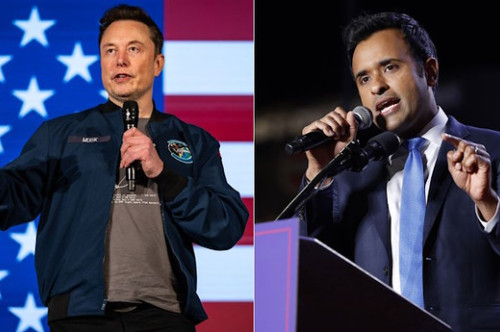
Adam Brandon is the Strategic Advisor for the Independent Center. He has a Center bias.
The memeification of the federal government is beginning. Entrepreneurs Elon Musk and Vivek Ramaswamy have been put in charge of a project—the “Department of Government Efficiency,” or “DOGE”—to slash federal spending. The acronym comes from the meme of a Shiba Inu dog that became popular in the 2010s.
Because we’re in an increasingly hyper-partisan atmosphere, some may dismiss DOGE as an unserious effort. We should take it seriously. It would be a mistake not to do so. The deficits and debt that the United States is accumulating are among the most pressing domestic problems that we face as a nation. We are staring down a sovereign debt crisis that JP Morgan Chase CEO Jamie Dimon has called “the most predictable crisis” in history.
Think of DOGE as a modern version of Ronald Reagan’s Private Sector Survey on Cost Control, which is better known as the Grace Commission. In January 1984, the Grace Commission made nearly 2,500 recommendations that, if adopted, would’ve saved $424 billion in waste over three years and $1.9 trillion over the long term.
Although most of the Grace Commission’s recommendations weren’t adopted, it set the standard for identifying areas of government waste and inefficiency. The biggest difference thus far is that the Grace Commission was officially sanctioned via an executive order. DOGE will apparently operate outside the confines of the federal government.
There’s room to reduce inefficient spending in existing programs. After all, we’re talking about a projected $6.975 trillion budget in FY 2025.
Some areas are low-hanging fruit. In fact, eight years ago, the Washington Post reported that the Department of Defense spiked a report that would’ve saved $125 billion over five years. Nothing has changed. The Pentagon has routinely failed independent audits and can’t account for nearly two-thirds of its $3.5 trillion in assets. Despite this lack of accountability and leadership, Congress appropriated $849 billion in defense spending for FY 2024.
The problem with that figure isn’t only its sheer size, but it’s also what it represents. In FY 2025, Medicare, Social Security, and net-interest on the share of the debt held by the public will represent 50% of all federal spending. Add other mandatory programs—including Medicaid and other healthcare programs, federal civilian and military retirement, and income security—and we’re now looking at nearly 74% of all federal outlays.
Medicare, Medicaid, and the State Children’s Health Insurance Program estimated a combined $103.6 billion in improper payments in FY 2023 alone. The Social Security Administration (SSA) made roughly $72 billion in improper payments from FY 2015 through FY 2022. Although the SSA has recovered most improper payments, $23 billion remains unrecovered and Congress has failed to fund SSA’s efforts to recover overpayments.
Obviously, DOGE should look into improving processes to reduce improper payments, but there’s not even close to enough waste, fraud, and abuse in Medicare, Medicaid, and Social Security to close the projected $1.9 trillion budget deficit for FY 2025. Cutting off funds for “woke” spending or Ukraine aren’t going to have much of an impact.
It would be a great start to cut $100 billion—and reducing inefficiency, duplication, and waste in the federal government are important, but Musk and Ramaswamy should make fiscal sustainability part of DOGE’s agenda. To make the United States fiscally sustainable, DOGE needs to think outside the box and develop recommendations to Congress to modernize Medicare, Medicaid, and Social Security.
The federal government is projected to spend nearly $2 trillion on healthcare in FY 2025. Why not give that money to the American people in the form of vouchers and allow them to go directly to the marketplace and purchase the health insurance they want and need? Except for current beneficiaries and those who expect to be on Medicare over the next several years, there’s no reason to pass that money through bureaucrats.
Apply those same concepts to Social Security. We keep current beneficiaries and those who will be on Social Security in a few years but give younger folks the chance to build real wealth. We can’t just tinker around the edges; we need to set a new goal of empowering individuals and families to have more choices.
Getting our fiscal house in order takes more than just spending reform. It also requires economic and population growth. We have a chance to attract the world’s best and brightest talent, as well as global capital. Think of it this way: we have 4% of the world’s population and 43% of its capital. If we’re growing, we’re dominating. Part of these reforms is ensuring we have the most innovative economy in the world, which is how we’ll compete with China in the long term and eventually outcompete them.
The idea behind DOGE is that the government should do a few things and do them well and transparently. As a divided nation, this effort to modernize the federal government isn’t something that can be rammed through Congress on a partisan basis.
Changes this big need to be forged with a bipartisan consensus to have credibility with the American people, particularly Millennial and Gen Z independent voters who decided the presidential election. These voters will decide whether DOGE is successful or not.











